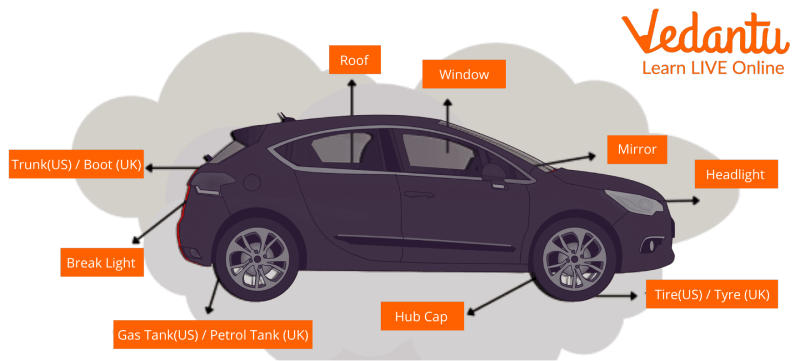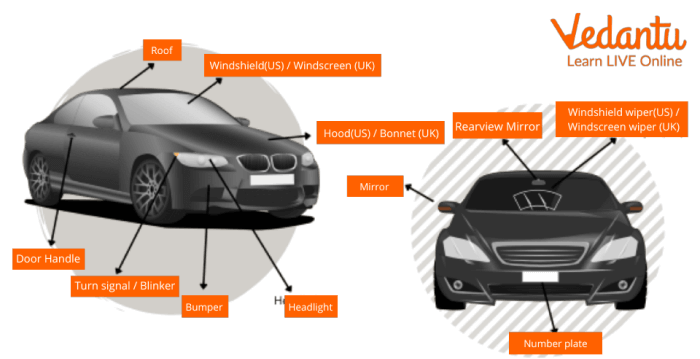




Essential Car Parts and Their Functions Explained
A car is a four-wheeled, motorised vehicle used by individuals to travel between locations (transportation). Cars typically have four wheels, seat one to eight people, and are primarily used to transport people as opposed to commodities. Controls are found in cars for a number of elements, including driving, parking, and passenger comfort. The engine, transmission, axles, differential, suspension, etc. can normally be found when you open your car hood up or look under the car. A responsible vehicle owner must have fundamental knowledge and comprehension of the vehicle they operate.
A car is packed with a variety of components, from the steering system to the front and rear suspension, that work together to move your car, or truck down the road. Understanding how the steering and suspension systems interact with the other components of your car will help you visualise how it works.
Parts of a Car
A single car has roughly 30,000 pieces and these are produced using various raw materials and production techniques.
The major 4 components of a car are-
A chassis
The Motor
System of transmission
Body

Parts of a Car
The Chassis
The frame, suspension, axles, and wheels make up the majority of an automobile's chassis. The frame might take the shape of a typical chassis or it might use unit construction.
The fundamental skeleton of the vehicle is formed by the frame in a traditional chassis frame. The engine and body of the vehicle are supported by the frame. Steel square or box-shaped pieces that are strong enough to withstand the weight of the body and other components are used to build the frame.
The Engine
The engine supplies power to drive the car, is a power generator, power plant, or motor. It is designed to transform the heat from burning gas into the force that rotates the vehicle's wheels.
Transmission System
The transmission's primary job is to change the torque that the engine applies to the wheels as needed. A car's gearbox is called a transmission. It is comparable to the bicycle's chain and gear shifter mechanism.
Body
The bodywork's primary function is to accommodate the driver and passengers while providing adequate wind and weather protection. The type of automobile and its price have an impact on how comfortable it is.

Parts of a Car from Top View
Steering System
The vehicle's direction can be changed via the steering system. The front wheels should have a propensity to return to the straight-ahead position following a turn, and any steering mechanism must be precise and simple to operate.
Headlights
A headlight is a lamp that is mounted on the front of a car to light the way. Although headlights and headlamps are frequently used interchangeably, in the most formal sense, headlight refers to the gadget's beam of light and headlamp to the device itself.
Turn Signal/Tail Lights
Above the bumper on the back of the automobile are positioned the taillights. They are white lights next to red ones that are used to signal when the car is in reverse. Tail lights help you drive safely in the dark by alerting other vehicles to your presence when you're on the road.
Trunk
In a sedan, coupe, or convertible, the car trunk serves as the major storage space for cargo or luggage. While the word "boot" is frequently used in other English-speaking nations, the phrase "trunk" is largely used in North America.
Gas Tank
Car's gasoline tank is normally under the back or in the centre of the car. Through a tiny hole that is covered by a gas cap when not in use, this tank can be topped off from the outside.
Licence Plate
A licence plate is required on every vehicle for identification. There are numerous bumper stickers on this car. You can adorn your car with these items. This is a list of produced automobile components, most of which are for internal combustion engine vehicles.
Summary
Knowledge about the car and description of its parts are briefly mentioned in this article. Through the article, you will get an idea of parts that are present in a car and how different parts coordinate and perform their mechanism. There are 4 major components of a car. These are a chassis, the motor, system of transmission and body. In body various parts of a car are discussed in detail with their functions.
FAQs on Car Parts Names with Pictures for Kids
1. What are the four most fundamental parts of a car?
The four most fundamental parts that make up a car are the chassis (the main frame), the engine (which provides power), the transmission system (which sends power to the wheels), and the body (the outer shell of the vehicle).
2. Which part of a car is often called its 'heart'?
The engine is often called the 'heart' of the car. Similar to how a heart pumps blood, the engine generates the power needed to make the car's wheels turn and propel the vehicle forward. Without it, the car cannot move on its own.
3. What are the main exterior parts of a car that we can see?
The main parts you can see on the outside of a car include:
Doors: To allow passengers to get in and out.
Windows: To provide visibility and let in light.
Wheels and Tyres: Which allow the car to roll smoothly on the road.
Headlights and Taillights: For visibility at night and signalling.
Bumpers: Located at the front and back for protection during minor impacts.
Bonnet (Hood): The cover for the engine compartment.
4. What important parts are found inside a car's cabin?
Inside a car's cabin, where the driver and passengers sit, you will find several important parts, such as the steering wheel to control direction, seats for comfort, seatbelts for safety, the dashboard which displays information like speed, and the pedals (accelerator, brake, and clutch).
5. Why are wheels and tyres so important for a car's movement?
Wheels and tyres are essential because they are the car's only point of contact with the road. They perform several crucial jobs: they support the car's entire weight, absorb shocks from uneven surfaces, and provide the grip (traction) needed for the car to accelerate, brake, and turn safely without slipping.
6. What is the job of the steering wheel in a car?
The job of the steering wheel is to give the driver control over the car's direction. When the driver turns the wheel, it moves a series of connected parts in the steering system that turn the front wheels left or right, guiding the vehicle exactly where the driver wants it to go.
7. What is the difference between a car's headlights and taillights?
The main difference lies in their location, colour, and function. Headlights are located at the front, are typically white or yellow, and illuminate the road ahead for the driver. Taillights are located at the back, are always red, and make the car visible to drivers behind, also indicating when the car is braking.
8. Why can't a car move without an engine?
A car cannot move without an engine because the engine is its primary power source. It works by burning fuel to create a controlled explosion, which generates the force needed to turn the car's wheels. Without the engine, there is no power to overcome inertia and friction, and the car remains stationary.
9. How do brakes work to keep us safe in a car?
Brakes keep us safe by allowing the driver to slow down or stop the car reliably. When the driver presses the brake pedal, the system uses hydraulic pressure to clamp brake pads onto a disc (or push shoes against a drum) attached to the wheel. This creates intense friction, which converts the car's kinetic energy (movement) into heat, effectively slowing the wheel's rotation and stopping the car.





















